Reviews
September 1, 2012
Version française...
Flash version here.
 After You, Mr. Gershwin After You, Mr. Gershwin
André Moisan, clarinet; Jean Saulnier, piano
ATMA Classique ACD2 2517

Smart thinking to gather selected composers who, in the Gershwin tradition, created a musical style on the border between jazz and classical, all the more so since the clarinet and the piano, polymorphous and adaptable instruments, lend themselves well to this mix. André Moisan and Jean Saulnier interpret this program that is somewhere between a rock and a hard place with great energy and a solid musical sense. There is a charming tribute to Gershwin composed by Bélà Kovács, some classical pieces bordering on jazz (Joseph Horowitz, Robert Muczynski, Mike Mower) as well as one from a jazz musician—Paquito D’Rivera—bordering on the classical! Daniel Mercure’s wonderful piece of gentle melancholy and heightened sensitivity should also be highlighted. These wonderful works, little known, yet very interesting when interpreted by these bright musicians, provide an infectious listening pleasure. Éric Champagne
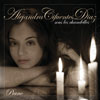 Alejandra Cifuentes Diaz...sous les Chandelles Alejandra Cifuentes Diaz...sous les Chandelles
Alejandra Cifuentes Diaz, piano
Maga Multi Média (49 min 50 s)

Alejandra Cifuentes Diaz is a young pianist who studied at the Université de Montréal. As many pianists before her have done, she offers an album composed of a medley of some of the best-known keyboard pieces. However, in this CD, which she produced, she does not attempt to blow the audience away by playing pieces of great virtuosity. Instead, she works her way through a repertoire rich in sensitivity, gentleness and even sensuality. The disc is composed of 12 pieces, each with an average length of less than five minutes. It is no surprise to find well-known works such as Beethoven’s Für Elise and Debussy’s Clair de Lune, but there are also lesser-known ones such as the 2nd movement of Bach’s Italian Concerto and the sarabande from Debussy’s suite Pour le piano. Each piece is interpreted with the requisite delicacy and one feels that the artist is in her element. The album’s short length, about fifty minutes, is regrettable, as are the background noises heard now and then. Despite this, the CD is a good investment if you wish to acquaint yourself with this promising pianist. Philippe Michaud
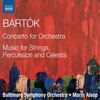 Bartók: Concerto for Orchestra; Music for Strings, Percussion and Celesta Bartók: Concerto for Orchestra; Music for Strings, Percussion and Celesta
Baltimore Symphony Orchestra/Marin Alsop
Naxos 8.572486 (67 min 27 s)

The quality of orchestral tone at Naxos has become perceptibly more refined over the last few years. Admittedly, the strings here lack presence (Concerto for Orchestra), or suffer from heavy reverberation (Music for Strings, Percussion and Celesta), although as a whole, the recording measures up to the stiffest competition. The same holds for the interpretation. There are many recordings of Bartók’s masterpieces demonstrating sincere authenticity (as much for the wild rhythm as for the folkloric character), but Ms. Alsop’s sensitive ear, combined with precise sound recording, allows the listener to enjoy fully the best orchestral qualities of the Concerto, while marvelling at the many subtleties of Music for Strings, too often missed by the microphone. René Bricault
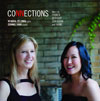 Connections – Franck: Sonata for Cello & Piano; Debussy: Sonata No. 1 for Cello & Piano; Chausson: Piece Op. 39; Fauré: Papillon Op. 77 Connections – Franck: Sonata for Cello & Piano; Debussy: Sonata No. 1 for Cello & Piano; Chausson: Piece Op. 39; Fauré: Papillon Op. 77
Winona Zelenka, cello; Connie Shih, piano
Marquis 774718142726 (54 min 21 s)

Winona Zelenka is a gifted Canadian artist who spent five seasons as Acting Principal Cellist of the Toronto Symphony Orchestra. Pianist Connie Shih developed an international career at a remarkably early age. On this fine-sounding new CD they make a great team playing mostly standard French repertoire. Zelenka has a wonderful technique and a maturity of phrasing that belies her years. Whether in its violin or cello version the Franck Sonata is often seriously overplayed, but Zelenka and Shih make it urgent and fresh once again. Shih certainly has the technique for the concerto-like piano part, but at times her tone lacks subtlety. The recording may be partly to blame.
I really enjoyed the Chausson Piece Op. 39, a work I had never heard before. But then there is so much Chausson that nobody knows or plays. Isn’t it time for a Chausson revival?
Incidentally, the “connections” of the title of the album have to do with the composers, wives and performers associated with these pieces. In her liner notes cellist Zelenka explains the connections with both charm and insight. Paul E. Robinson
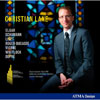 Christian Lane: 1st Prize – Canadian International Organ Competition 2011 Christian Lane: 1st Prize – Canadian International Organ Competition 2011
Christian Lane, organ
ATMA ACD2 2674 (74 min 38 s)

American organist Christian Lane impressed the audience and the jury of the second Canadian International Organ Competition in 2011. Thanks to this victory, he returned in early 2012 to record a recital for the ATMA label at Saints-Anges de Lachine on their Casavant, signed “opus 869”. Christian Lane chose a rather panoramic approach to the recital rather than exploring in depth one or two more substantial works. He nevertheless concentrates his attention on romanticism and its more modern derivatives, from Schumann to Dupré via Elgar, Liszt, Roger-Ducasse, Vierne, and Whitlock. This repertoire suits him well. The young performer, associated with Harvard, has a delicate touch, is attentive to subtle nuances and quite talented as a colourist. Roger-Ducasse’s Pastorale possesses a delightful, folksy charm, and Vierne’s Clair de Lune is quite accomplished, with its diaphanous textures. And Liszt’s Variations Weinen, Klagen, Sorgen, Zagen is very pleasing. The harmonic discourse is well mastered and the dynamic contrasts are skillfully conducted, increasing the affective potential of the work. A beautiful album. Frédéric Cardin
 Giovanni Battista Pergolesi: Stabat Mater & Laudate Pueri Giovanni Battista Pergolesi: Stabat Mater & Laudate Pueri
Valer Barna-Sabadus, Terry Wey, countertenor; Neumeyer Consort Ensemble Barock Vokal, Mainz/Michael Hofstetter
Oehms Classics OC831

One of the most beautiful works of the 18th century, Pergolesi’s Stabat Mater never ceases to fascinate and touch audiences. The premature death of the composer, at just 26, gives this work a special aura, not unlike that of Mozart and his Requiem. Here, the Stabat Mater is sung by two men, as was the custom during the period. A string ensemble, reduced to a violin by the end, accompanies the two countertenors. This creates a feeling of proximity with the artists. The timbre of their voices being similar, the singers complement each other quite well. We have here an excellent execution by the ensemble, light and seductive, free from the excessive pathos that is too often heard in this celebrated work. In fact, this version is closer to opera than pure religious vision. But the true star of this album is Valer Barna-Sabadus, who sings soprano. The ease with which he reaches the highest notes while embellishing them with superb ornaments is astonishing. His voice is a constant pleasure, especially in the joyful Laudate Pueri. Quite simply a phenomenon! René François Auclair
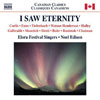 I Saw Eternity I Saw Eternity
Elora Festival Singers/Noël Edison
Naxos 8.572812 (73 min 58 s)

The second edition in the series Canadian Classics from Naxos, this repertoire of English-Canadian choral music is a beautiful discovery. This album includes 11 works by as many composers who subscribe to the traditional school of choral writing – traditional writing, certainly, but of an undeniably intrinsic beauty. The proof can be found in the very beautiful Missa brevis by Ruth Watson Henderson and Marjan Mozetich’s ethereal Flying Swans. There are few celebrity composers represented here—the exceptions being Glenn Buhr and Stephen Chatman, established composers with imposing repertoires— but a nice range of recent choral compositions from the English side of Canada. The Elora Festival Singers, an Ontarian chamber choir, demonstrates quality sound and uncommon artistry. It is a real pleasure to listen to their beautiful timbres and perfect vocal harmony. Naxos has hit the mark with the second opus of this promising series. We fervently hope to find Quebecois artists and performers among future editions. Until then, we have plenty to sustain our ears and mind! Éric Champagne
 Les Goûts Accordés: Robert de Visée - Jean-Baptiste Barrière Les Goûts Accordés: Robert de Visée - Jean-Baptiste Barrière
Esteban La Rotta, theorbo; Jivko Georgiev, 5-string cello; Margaret Little, viola da gamba; Katelyn Clark, organ
ATMA Classique ACD22673

The Italian style, popular throughout Baroque Europe, had no trouble crossing the French border. Soon, new musicians were trying to reconcile the different “tastes”. This disc demonstrates the evolution of French music in this period. Robert de Visée (1655-1732), guitarist and lutist at the court of the Sun King, composed numerous dance suites that were richly ornamented, meditative, exuding a certain lyricism, but limited at the melodic level. The theorbo used here replaces the baroque guitar often used in Visée’s music. Unfortunately, the result is disappointing. The instrument rings false from the first notes, and we rapidly lose interest in the music, no matter how beautiful it may be. However, with Jean-Baptiste Barrière (1707-1747), everything brightens up! Impregnated with Italian sunshine while still being sumptuously French, his music is utterly charming. Jivko Georgiev’s facility and flexibility in executing these little-known scores on a five-string cello approaching the viola da gamba is astonishing. Margaret Little follows his slightest inflections in the basso continuo. Knowing that more than twenty of these beautiful sonatas exist, an entire album should have been devoted to Barrière! René François Auclair
 Mendelssohn: Violin Concerto; Schumann: Violin Concerto/Fantasy for Violin and Orchestra Op. 131 Mendelssohn: Violin Concerto; Schumann: Violin Concerto/Fantasy for Violin and Orchestra Op. 131
Christian Tetzlaff, violin; Frankfurt Radio Symphony Orchestra/Paavo Järvi
Ondine CD ODE 1195-2 (69 min 3 s)

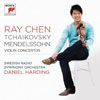 Mendelssohn: Violin Concerto; Tchaikovsky: Violin Concerto Mendelssohn: Violin Concerto; Tchaikovsky: Violin Concerto
Ray Chen; violin; Swedish Radio Symphony Orchestra/Daniel Harding
Sony 88697984102 (63 min 50 s)

There seems to be a new recording of the Mendelssohn Violin Concerto almost every month. The celebrated German violinist Christian Tetzlaff has been playing it for years to great acclaim and the young Taiwanese artist Ray Chen played it when he won the Menuhin Competition in 2008. While Chen has the more voluptuous tone Tetzlaff plays Mendelssohn with far more freedom and imagination.
Chen plays the Tchaikovsky with impressive virtuosity but again without much freshness. Tetzlaff’s couplings are relative rarities by Robert Schumann. In my opinion the Fantasy is not among the composer’s best works and the Concerto—except for the beautiful slow movement—is repetitious and tiresome.
Paavo Järvi offers excellent partnership for Tetzlaff, especially in the Mendelssohn. On the other hand, the orchestra is consistently too loud on both recordings. I would guess this is the fault of the engineers rather than the conductors. Paul E. Robinson
 Shawn Mativetsky: Cycles Shawn Mativetsky: Cycles
Shawn Mativetsky, tablas; Marie-Hélène Breult, flute; Catherine Meunier, vibraphone; Xenia Pestova, harmonium; Windsor Symphony Orchestra/Brian Current.
Ombú 1015 (67 min 42 s)

Percussionist Shawn Mativetsky is the specialist and defender of quite a fascinating Indian percussion instrument: the tabla. An instrument of subtle and surprising inflections, the tabla is absolutely charming. For this new disc, Shawn Mativetsky has called upon five Canadian composers to create works in which traditional classical Indian music finds a resonance in a contemporary North American discourse. The musical fusion is successful and particularly interesting. Christian Ledroit, Nicole Lizée, Bruno Paquet, Jim Hiscott and Paul Frehner deliver creations that are sensitive, exhilarating, and downright bewitching. It’s also worth emphasizing the extraordinary complicity of the musicians collaborating with Shawn Mativetsky. That the musicians enjoy playing together is quite audible and contributes to the sharing and appreciation of this warm, captivating and human music. A must! Éric Champagne
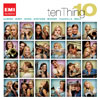 tenThing tenThing
Tine Thing Helseth, trumpet; tenThing
EMI 50999 0 88326 2 7 (68 min 46 s)

It would seem that Norwegian trumpeter Tine Thing Helseth aspires to outdo Allison Balsom with her physical charms, blond locks, technical virtuosity and sumptuous sound. The 25-year-old young woman from Oslo has gone further than her British counterpart by forming her own all-female brass ensemble, rather like a Scandinavian version of Angèle Dubeau’s La Pietà, with trumpets, horn, trombones and tuba! The repertoire of this first disc recorded on EMI is utterly approachable and consists of arrangements of well-known music. Bizet’s Carmen Suite, Albeniz’s Asturias and Mozart’s Rondo alla Turca rub shoulders with some pretty tunes by Grieg, two pieces by Piazzolla and a brass arrangement of Weill’s Threepenny Opera. The only works originally for brass ensemble are two pieces by Jan Koetsier, a little-known Dutch composer who died in 2006, namely his Brass Symphony Op. 80 and Grassauer Zwiefacher. The symphony is sonorous, rhythmically engaging and not much avant-garde. Despite the unavoidable moments of thundering brass, the work is basically pleasant. The young musicians bring great energy to the ensemble and they have a beautiful sound. Frédéric Cardin
DVD
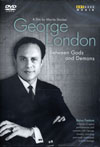 George London: Between Gods and Demons George London: Between Gods and Demons
A film by Marita Stocker
Arthaus Musik 101 473 (60 min + 95 min bonus)

The DVD title says it all—whether he was singing Wotan or Mefistopheles, Montreal-born, American-trained George London (1920–1985) brought to his wide-ranging repertoire his unique mix of unfailing musicality and dramatic intensity. From the late 1940s to 1967, when a paralyzed vocal cord led to his premature retirement at 46, London was an unforgettable Wotan, Mefistopheles, Scarpia, Amfortas, Wolfram, Mandryka, Iago, and Don Giovanni, to name a few. He had the distinction of being the first non-Russian to sing Boris at the Bolshoi in 1960, at the height of the Cold War. His voluminous, dark-hued bass-baritone, with its somewhat veiled quality, was unique in timbre and ideal as the tortured Amfortas, the evil Scarpia, or the tragic Boris. This German documentary does an excellent job of exploring the life and art of this great singer, through many interviews with his colleagues and former students, and most importantly his wife, Nora London. After his enforced retirement, London became an influential teacher. He trained many singers and supported them through the George London Foundation. Several have gone on to major international careers, among them Neil Shicoff, Deborah Polaski and Catherine Malfitano. They speak of their former teacher with respect and admiration in the documentary. The generous bonus material on the DVD consists of previously unreleased archival footage of live opera performances with London as Figaro, Don Giovanni, Mefistopheles, Iago, Boris, Wotan, and Scarpia, this last opposite the incandescent Tosca of Maria Callas. Also interesting are rare clips of London singing Spirituals, Broadway show tunes and Schubert lieder. This DVD is an indispensable document of this great singer. Joseph K. So
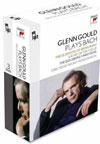 Glenn Gould Plays Bach Glenn Gould Plays Bach
Bruno Monsaingeon, director
Sony Classical (3 DVD: 57 min 7 s, 57 min 21 s, 57 min 55 s)

Sony had the happy idea of bringing together in one box the three documentaries made by French violinist and film maker Bruno Monsaingeon between 1977 and 1980, shedding light on Glenn Gould’s very personal conception of the music of Bach and on how he performed it at the piano. The first film is dedicated to the question of the instrument itself, particularly thorny at that moment, when the Baroque revival was challenging established norms of performance. The second is concerned with the importance of the fugue in music generally and particularly in the case of Bach. The last is dedicated to the Goldberg Variations, the masterpiece still relatively little played in 1955, with which Gould decided to begin his recording career. The pianist, who had been retired for some twenty years at the time of filming, died shortly afterwards, making these three cinematic documentaries important artefacts of music history. Composition, editing and lighting all serve to lend vitality and piquancy to Gould’s reflections, many of which are paradoxical (for example, his dislike of the Chromatic Fantasy), but always interesting. In the first two DVDs, Gould demonstrates at the piano, playing several excerpts, some complete fugues, and even some longer pieces such as the Fourth Partita. In his classic rendition of the Goldberg Variations, we see and hear Glenn Gould, on his famous low chair, in a seemingly uncomfortable posture, accompanied by his murmurings and sound-sculpting gestures, as the incomparable music pours from his old Steinway. Alexandre Lazaridès
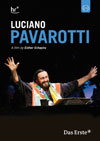 Luciano Pavarotti Luciano Pavarotti
A film by Esther Schapira
Euroarts 2058918 (58 min + bonus 35 min)

At the risk of hyperbole, there is Pavarotti and then there’s everyone else. No tenor in the past half-century could surpass him for his bigger than life personality, and none possessed the sunny Mediterranean quality that makes the voice immediately recognizable. Never mind that he could not read music, wasn’t a paragon of discipline, and had a limited repertoire—none of this mattered, as his hold on the public was legendary. Complementing the material already available on Pavarotti the Artist is this new German language documentary on Pavarotti the Man. From his earliest years to his untimely death from pancreatic cancer in September 2007, the documentary traces his life and career with candour and sensitivity. There are plenty of interviews—his wife Adua Veroni, boyhood friend Luciano Ghelfi, personal assistant Edwin Tinoco, colleagues Mirella Freni and Jose Carreras, agent Herbert Breslin, Met intendant Joseph Volpe, conductor and coach Leone Magiera, even celebrity friend/fan Bono. The one conspicuously absent is second wife Nicoletta Mantovani, who could not participate due to first wife Adua’s condition for her own participation in the documentary. The film captures Pavarotti well, his sunny personality, his generosity of spirit, his zest for life—and food, not to mention his appreciation of feminine beauty. The documentary is gossipy but respectful—there’s no mud slinging. Lamentably short at 58 minutes, the documentary goes by in a flash. The bonus includes extra interview material of Bono, Carreras, Breslin and Volpe. This is an absolute must-see for anyone interested in the charismatic Luciano Pavarotti. Joseph K. So
Blu-ray
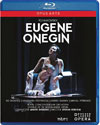 Tchaikovsky: Eugene Onegin Tchaikovsky: Eugene Onegin
Bo Skovhus (Eugene Onegin); Andrej Dunaev (Lensky); Mikhail Petrenko (Prince Gremin); Krassimira Stoyanova (Tatyana); Chorus of De Nederlandse Opera; Royal Concertgebouw Orchestra Amsterdam/Mariss Jansons
Philipp Fürhofer, sets; Gesine Völlm, costumes
Stefan Herheim, director
Opus Arte OA BD7100D (151 min + 30 min. bonus)

This 2011 production from the Nederlandse Opera created an uproar in the opera world. Director Stefan Herheim brings an original (and, to some purists, controversial) interpretation to the libretto, based on Pushkin’s classic novel. It’s as if we were walking through a temporal kaleidoscope, beginning in the early twentieth century, passing through Soviet Russia, and ending in our own day. The sumptuous and glittering costumes, the breath-taking and marvellously coloured sets, and the stage direction, lively despite the static quality of the libretto, make this an unforgettable production. And as if that weren’t enough, the Dutch orchestra led by Mariss Jansons performs with extraordinary energy and flamboyance. The vocal soloists are impeccable. Everything is of an extremely high artistic quality. If you love opera, and particularly Tchaikovsky, you simply cannot pass up this spectacular Blu-ray. Frédéric Cardin
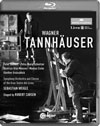 Wagner: Tannhäuser Wagner: Tannhäuser
Orquestra Simfònica and Cor del Gran Teatre del Liceu/Sebastian Weigle; Peter Seiffert (Tannhäuser), Petra Maria Schnitzer (Elisabeth), Béatrice Uria-Monzon (Venus), Markus Eiche (Wolfram) and Günther Groissböck (Landgrave)
Robert Carsen, director
Unitel Classica 709404 (Blu-Ray: 201 min)

Canadian Robert Carson has imagined his Tannhäuser as a contemporary painter rejected by his peers, thereby disregarding the complete title of the work (“…and the Singers’ Contest at Wartburg”) and the mysticism that pervades the Wagnerian universe. Torn between the vision of the composer and of that of the director, the transposition juggles with the values of disparate historical periods. The overburdened scenography seems to operate outside the scope of the music and text, which should in principle give the work its grounding force. Inconsistencies are inevitable with such a non-literal reading, requiring the suspension of critical thinking. In the third act, when Wolfram declares, “I knew full well I’d find her here in prayer,” we see Elisabeth, in a state of undress, writhing in a swoon on Venus’s bed, which we saw in the first act. The incongruity causes us to question the character’s integrity and the logic of the adaptation. Afterwards, Elisabeth (whom Wagner kills) rejoins Venus on said mattress, appearing, despite their rivalry, as twins draped in identical white, one brunette, the other blonde. Tannhäuser chooses not to choose between them, and his paintings become triumphs in the art world. The Liceu’s production is brought off by the singers, but the orchestra seems a bit disengaged. Alexandre Lazaridès
Translation: Rebecca Clark, Rona Nadler, Karine Poznanski
Version française... |
|


